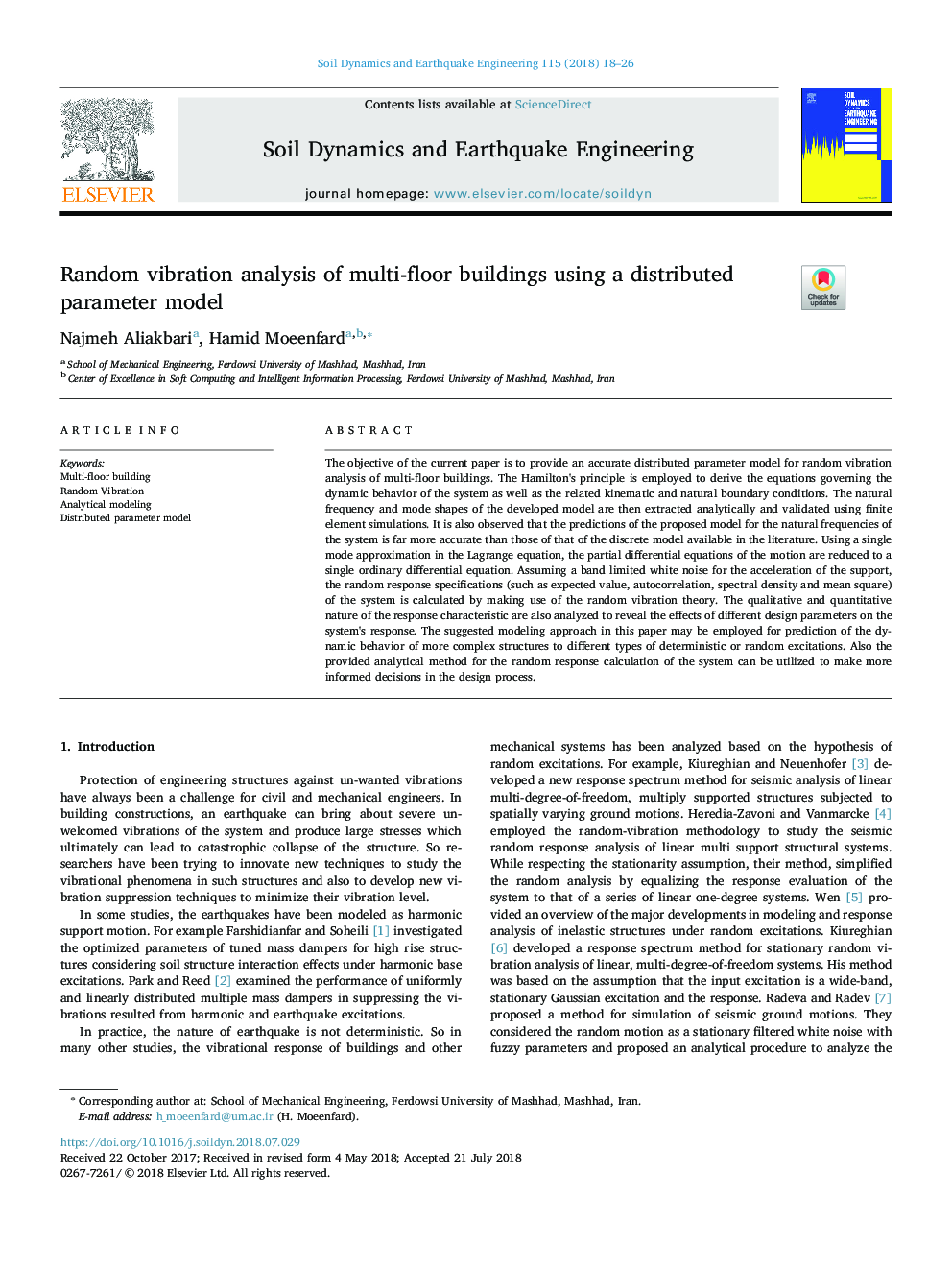| کد مقاله | کد نشریه | سال انتشار | مقاله انگلیسی | نسخه تمام متن |
|---|---|---|---|---|
| 8947150 | 1645552 | 2018 | 9 صفحه PDF | دانلود رایگان |
عنوان انگلیسی مقاله ISI
Random vibration analysis of multi-floor buildings using a distributed parameter model
ترجمه فارسی عنوان
تجزیه و تحلیل ارتعاش تصادفی ساختمان های چند طبقه با استفاده از یک مدل پارامتر توزیع شده
دانلود مقاله + سفارش ترجمه
دانلود مقاله ISI انگلیسی
رایگان برای ایرانیان
کلمات کلیدی
ساختمان چند طبقه، ارتعاش تصادفی، مدل سازی تحلیلی، مدل پارامتر توزیع،
ترجمه چکیده
هدف مقاله حاضر ارائه یک مدل پارامتر دقیق توزیع شده برای تجزیه و تحلیل ارتعاش تصادفی ساختمان های چند طبقه است. اصل همیلتون برای بدست آوردن معادلات حاکم بر رفتار دینامیکی سیستم و همچنین شرایط مرزی سینماتیک و طبیعی طبیعی استفاده می شود. شکل های فرکانس طبیعی و حالت مدل توسعه یافته سپس آنالیز و اعتبار سنجی با استفاده از شبیه سازی عناصر محدود می شود. همچنین مشاهده می شود که پیش بینی مدل پیشنهادی برای فرکانس های طبیعی سیستم بسیار دقیق تر از مدل های گسسته موجود در ادبیات است. با استفاده از تقریب یک حالت در معادله لاگرانژ، معادلات دیفرانسیل مختلف جزئی حرکت به یک معادله دیفرانسیل معمولی کاهش می یابد. با در نظر گرفتن یک نویز سفید سفید باند برای تسریع پشتیبانی، مشخصات پاسخ تصادفی (مانند مقدار انتظار، همبستگی خودکار، تراکم طیفی و میانگین مربع) سیستم با استفاده از تئوری ارتعاش تصادفی محاسبه می شود. ماهیت کیفی و کمی از خصوصیات پاسخ نیز برای تحلیل اثرات پارامترهای مختلف طراحی بر روی پاسخ سیستم مورد تجزیه و تحلیل قرار گرفته است. روش پیشنهادی مدل سازی در این مقاله می تواند برای پیش بینی رفتار پویا ساختارهای پیچیده تر به انواع مختلف تحرک های قطعی یا تصادفی مورد استفاده قرار گیرد. همچنین روش تحلیلی ارائه شده برای محاسبه پاسخ تصادفی سیستم می تواند برای تصمیم گیری های آگاهانه تر در فرآیند طراحی مورد استفاده قرار گیرد.
موضوعات مرتبط
مهندسی و علوم پایه
علوم زمین و سیارات
مهندسی ژئوتکنیک و زمین شناسی مهندسی
چکیده انگلیسی
The objective of the current paper is to provide an accurate distributed parameter model for random vibration analysis of multi-floor buildings. The Hamilton's principle is employed to derive the equations governing the dynamic behavior of the system as well as the related kinematic and natural boundary conditions. The natural frequency and mode shapes of the developed model are then extracted analytically and validated using finite element simulations. It is also observed that the predictions of the proposed model for the natural frequencies of the system is far more accurate than those of that of the discrete model available in the literature. Using a single mode approximation in the Lagrange equation, the partial differential equations of the motion are reduced to a single ordinary differential equation. Assuming a band limited white noise for the acceleration of the support, the random response specifications (such as expected value, autocorrelation, spectral density and mean square) of the system is calculated by making use of the random vibration theory. The qualitative and quantitative nature of the response characteristic are also analyzed to reveal the effects of different design parameters on the system's response. The suggested modeling approach in this paper may be employed for prediction of the dynamic behavior of more complex structures to different types of deterministic or random excitations. Also the provided analytical method for the random response calculation of the system can be utilized to make more informed decisions in the design process.
ناشر
Database: Elsevier - ScienceDirect (ساینس دایرکت)
Journal: Soil Dynamics and Earthquake Engineering - Volume 115, December 2018, Pages 18-26
Journal: Soil Dynamics and Earthquake Engineering - Volume 115, December 2018, Pages 18-26
نویسندگان
Najmeh Aliakbari, Hamid Moeenfard,
